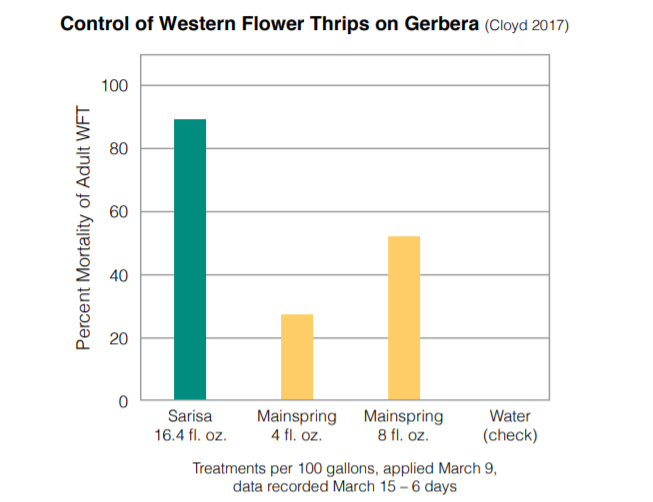Knowde Enhanced TDS
Identification & Functionality
- Chemical Family
- IRAC Code
- Agrochemical Functions
- Technologies
- Product Families
- Composition
ACTIVE INGREDIENT: Cyclaniliprole 4.55% OTHER INGREDIENTS 95.45% TOTAL 100.0% *3-bromo-N-[2-bromo-4-chloro-6[[(1-cyclopropylethyl)amino]carbonyl]phenyl]-1-(3-chloro-2-pyridinyl)-1H-3-pyrazole-5-carboxamide Contains 0.42 pounds Cyclaniliprole per Gallon (50 grams per liter)
Features & Benefits
- Product Highlights
SARISA contains cyclaniliprole in a soluble concentrate formulation used as a foliar spray.
- Common Name: Cyclaniliprole
- Class: Anthranillic diamide (MOA 28)
RESTRICTED ENTRY INTERVAL (REI) AND SIGNAL WORD
- REI = 4 hours
- Signal Word = CAUTION
- Key Insects Controlled
Insects included are (but not limited to):
- Adelgids
- Armyworms
- Borers
- (Beetle and Caterpillar)
- Flea Beetles
- Gypsy Moths
- Plant Bugs
- Japanese Beetles
- Lace Bugs
- Leafminers
- Leafrollers
- Loopers
- Mealybugs**
- Psyllids
- Root Weevil Complex
- (Adults)
- Thrips**
- Webworms
- Whiteflies
** suppression
- Product Info
SARISA is an insecticide with foliar activity for use on ornamentals, conifers, Christmas trees and non-bearing fruit, nut and vines grown in commercial greenhouses, shadehouses and nurseries. SARISA must be applied in protective programs and used in rotation with products with a different mode of action.
MIXING AND SPRAYING SARISA can be used effectively in dilute or concentrate sprays. Thorough, uniform coverage is essential for pest control. NOTE: Slowly invert container several times to assure uniform mixture of formulation before adding this product to the spray tank. SARISA may be applied with all types of spray equipment normally used for ground, chemigation and through sprinkler irrigation applications and aerial applications.
Applications & Uses
- Markets
- Applications
- Applicable Crop
- Application Technique
- Insecticide Target Species
- Mode Of Action
SARISA is both a contact and translaminar insecticide affecting the nerve and muscle systems
- Use Sites
SARISA is for broad-spectrum control of insect pests on ornamental greenhouse and nursery stock.
- Application Rates
SARISA rates range from 10.9 to 27.0 fl. oz. per 100 gallons depending on the target pest. Refer to the label for specific rates. For heavy pest infestations and maximum residual control use the high label rates and include an appropriate spray adjuvant
- Tank Mixing
SARISA has been found to be compatible with all commonly used fungicides, miticides, liquid fertilizers and other insecticides. It is recommended, however, to check compatibility if local experience is not available. Do not leave SARISA in a tank overnight. Mix only what you will use immediately. The use of a high-quality adjuvant at a rate of 0.025% to 0.1% on a volume to volume basis may improve performance.
- Resistance Management
Some insect pests are known to develop resistance to products used repeatedly for insect control. SARISA is an anthranilic diamide insecticide (MOA 28) and affects insects through Ryanodine receptor modulation. An insect management program that includes alternation or tank mixes between SARISA and other labeled insecticides that have different modes of action and/or control insect pests not controlled with SARISA is essential to prevent insecticide resistant insect populations from developing. SARISA should not be utilized continuously or tank mixed with insecticides that have shown to have developed insecticide resistance to the target insect pest.
Control of Western Flower Thrips on Gerbera (Cloyd 2017)

- Directions For Use
It is a violation of Federal law to use this product in a manner inconsistent with its labeling.
DO NOT apply this product in a way that will contact workers or other persons, either directly or through drift. Only protected handlers may be in the area during application. For any requirements specific to your State or Tribe, consult the agency responsible for pesticide regulation
- Agricultural Use Requirements
Use this product only in accordance with its labeling and with the Worker Protection Standard, 40 CFR Part 170. This Standard contains requirements for the protection of agricultural workers on farms, forests, nurseries, and greenhouses and handlers of agricultural pesticides. It contains requirements for training, decontamination, notification, and emergency assistance. It also contains specific instructions and exceptions pertaining to the statements on this label about personal protective equipment (PPE), and restricted-entry interval. The requirements in this box only apply to uses of this product that are covered by the Worker Protection Standard. DO NOT enter or allow worker entry into treated areas during the Restricted Entry Interval (REI) of four (4) hours. PPE required for early entry into treated areas that is permitted under the Worker Protection Standard and that involves contact with anything that has been treated, such as plants, soil, or water, are: coveralls, chemical resistant gloves made of waterproof material (such as, barrier laminate, butyl rubber, nitrile rubber, neoprene rubber, polyvinyl chloride or viton), shoes plus socks, and protective eyewear. Commercial greenhouses and nurseries are within the scope of the Worker Protection Standard.
Safety & Health
- Personal Protective Equipment (Ppe)
Applicator and other handlers must wear:
- Long-sleeved shirt and long pants
- Chemical resistant gloves
- Shoes with socks
- Protective eyewear
- Precautionary Statements
HAZARDS TO HUMANS AND DOMESTIC ANIMALS
CAUTION Harmful if swallowed or absorbed through skin. Causes moderate eye irritation. Avoid contact with skin, eyes or clothing. Wash thoroughly with soap and water after handling and before eating, drinking, chewing gum, using tobacco or using the toilet. Remove and wash contaminated clothing before reuse.
- User Safety Recommendations
- Wash hands before eating, drinking, chewing gum, using tobacco or using the toilet.
- Remove clothing/PPE immediately if pesticide gets inside. Then wash thoroughly and put on clean clothing.
- Remove PPE immediately after handling this product. Wash the outside of gloves before removing. As soon as possible, wash thoroughly and change into clean clothing.
- Environmental Hazards
This pesticide is toxic to aquatic invertebrates and oysters. Do not apply directly to water. Drift and runoff may be hazardous to aquatic organisms in water adjacent to use sites. This product is highly toxic to bees and other pollinating insects exposed to direct treatment or to residues in/on blooming crops or weeds. Protect pollinating insects by following label directions intended to minimize drift and to reduce risk to these organisms.
Do not apply this product or allow it to drift to blooming crops or weeds while bees or other pollinating insects are foraging the treatment area. DO NOT apply directly to water, or to areas where surface water is present or to intertidal areas below the mean high water mark. DO NOT contaminate waters when disposing of equipment washwater or rinsate. DO NOT apply when weather conditions favor drift from the treated areas. Drift and runoff may be hazardous to aquatic organisms in water adjacent to treated areas.
AVOIDING SPRAY DRIFT AT THE APPLICATION SITE IS THE RESPONSIBILITY OF THE APPLICATOR. The interaction of many equipment and weather-related factors determine the potential for spray drift. The applicator is responsible for considering all these factors when making decisions. Where states have more stringent regulations, they must be observed.
Packaging & Availability
- Packaging Type
- Packaging
- 0.5 gallon (64 fl. oz.) container, 4 per case
Storage & Handling
- Storage And Disposal
DO NOT contaminate water, food or feed by storage or disposal.
PESTICIDE STORAGE: Store in original container, in a secured, dry, cool place separate from food, pet food, feed, seed and fertilizer. Avoid cross-contamination with other pesticides.
PESTICIDE DISPOSAL: Pesticide wastes may be hazardous. Improper disposal of excess pesticide, spray mixture or rinsate is a violation of Federal law. If these wastes cannot be disposed of by use according to label instructions, contact your State Pesticide or Environmental Control Agency or the Hazardous Waste representative at the nearest EPA Regional Office for guidance.
CONTAINER HANDLING: Nonrefillable container DO NOT reuse or refill this container. Triple rinse container (or equivalent) promptly after emptying. Triple rinse as follows: Empty the remaining contents into application equipment or a mix tank and drain for 10 seconds after the flow begins to drip. Fill the container ¼ full with water and recap. Shake for 10 seconds. Pour rinsate into application equipment or a mix tank or store rinsate for later use or disposal. Drain for 10 seconds after the flow begins to drip. Repeat this procedure two more times. Then offer for recycling if available, or puncture and dispose of in a sanitary landfill, or by incineration or, if allowed by state and local authorities, by burning. If burned, stay out of smoke.

